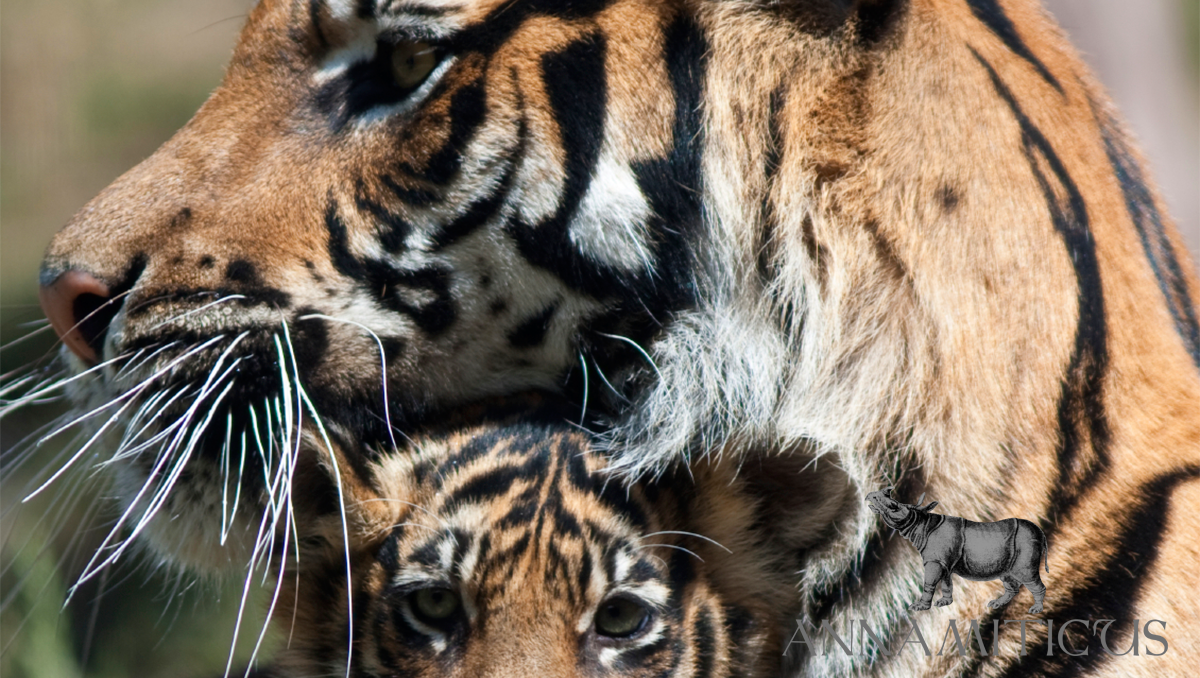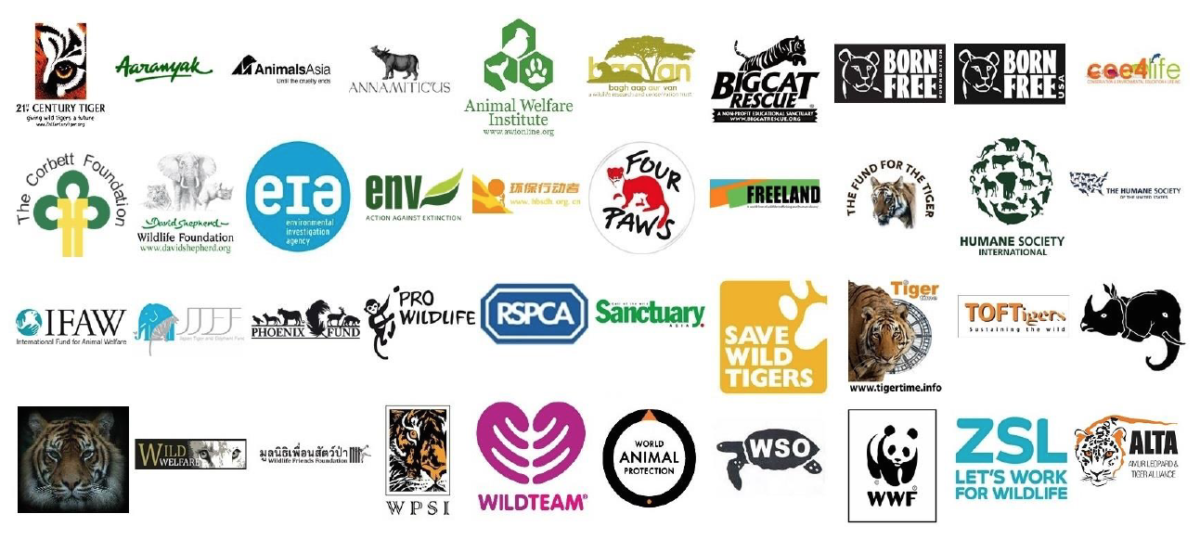
Today on International Tiger Day we the undersigned 45 non-governmental organisations are urging countries with tiger farms to adopt urgent action to end tiger breeding for commercial purposes and phase out tiger farms.
The global wild tiger population is estimated to be less than 4,000. These last remaining wild tigers are each threatened by trade for nearly all of their body parts – from skins and bones to teeth and claws – traded by criminals for huge profit. These products are consumed largely as exotic luxury products for demonstrating social status, such as tiger skin rugs for luxury home décor or expensive tiger bone wine. Tiger bone is also consumed as traditional medicine. The main market for tiger products are consumers in China and Vietnam, followed by smaller consumer markets in Myanmar and Laos.
There are currently two primary sources for trade in tiger parts and products: wild tigers in ten range countries that are home to the last remaining wild tigers, and captive tigers largely found in four tiger farming countries – China, Laos, Thailand and Vietnam.
Tiger farming and trade in captive tiger body parts from and through these countries undermines tiger conservation efforts across Asia.
Indeed trade in captive tiger parts and products stimulates demand for tiger products – be it from wild or captive tigers – and undermines enforcement efforts by making it difficult to know whether seized tiger products come from wild or captive tigers.
Tiger farms have expanded rapidly over the last few decades. In the four tiger farming countries alone, there are approximately 7,000 – 8,000 captive tigers in large tiger farms, zoos and smaller facilities that keep or breed tigers.
The wild tiger population has declined by over 95 percent over the last 100 years. 2016 has also marked a significant upsurge in tiger poaching and trade where in India more tigers were killed in the first five months of 2016 that in the whole of 2015.
The tiger range countries where tiger populations are beginning to show signs of recovery have high levels of political commitment, strong laws and enforcement – and no tiger farms.
Where tiger farms are present they only serve as an obstacle to recovery. In recent years China and Thailand have both delivered important new tiger conservation efforts on the ground. Despite this investment, the effects of tiger farms limit the potential gains from such work, as well as damaging those countries’ reputation in the area of species conservation.
We commend the recent bold enforcement efforts of Thailand’s Department of National Parks, Wildlife and Plant Conservation (DNP), which in June 2016 seized 137 live tigers thousands of tiger skin amulets, 70 preserved cubs and other tiger parts from the “Tiger Temple” in Kanchanaburi Province.
The DNP has announced that it will investigate other captive tiger facilities implicated in tiger trade. This represents a significant opportunity for Thailand to end all tiger farming within its borders and to play a leadership role in the phase-out of tiger farms in the region.
Other countries should also take action to ensure that they are not implicated in the trade in captive tiger parts and products. For example, there appears to be a growing trade in tigers and their parts and products from South Africa. The United States also has a large number of captive tigers which may too become vulnerable to exploitation for illegal trade.
The world needs to wake up to the alarm bells ringing across the tiger’s range. It is clear that tiger farming and trade in captive tiger parts have done nothing to end the pressure on and trade in wild tigers.
In September this year, world governments will come together in South Africa to participate in the 17th Conference of the Parties to the Convention on International Trade in Endangered Species of Wild Fauna and Flora (CITES). The CITES conference offers a significant opportunity for governments to adopt and call for urgent implementation of concrete measures to phase out tiger farms.
If wild tiger populations are to be recovered and secured, the international community must provide support to end tiger farming and all trade in tiger parts and products from wild and captive tigers. We the undersigned, including those with technical expertise in managing captive tigers, stand ready to provide assistance to achieve the goals of Zero Demand for tiger parts and products and Zero Poaching of tigers.

1. Esther Conway, Manager, 21ST CENTURY TIGER
2. Bibhab Kumar Talukdar, Ph.D., Secretary General and CEO, AARANYAK
3. Toby Zhang, Executive Secretary-General, AITA FOUNDATION
4. Jo Cook, ALTA Coordinator, AMUR LEOPARD AND TIGER ALLIANCE (ALTA)
5. Jill Robinson MBE, Dr. med vet hc, Hon LLD, Founder & CEO, ANIMALS ASIA FOUNDATION
6. Susan Millward, Executive Director, ANIMAL WELFARE INSTITUTE
7. Rhishja Cota-Larson, President, ANNAMITICUS
8. Kris Vehrs, Interim President and CEO, ASSOCIATION OF ZOOS AND AQUARIUMS
9. Dr. R.S. Chundawat, President, BAAVAN – BAGH AAP AUR VAN
10. Carole Baskin, CEO and Founder, BIG CAT RESCUE
11. Will Travers OBE, President & CEO, BORN FREE FOUNDATION
12. Adam Roberts, CEO, BORN FREE USA
13. Sybelle Foxcroft, Director, CEE4LIFE
14. Sally Case, CEO, DAVID SHEPHERD WILDLIFE FOUNDATION
15. Dung Nguyen, Vice Director, EDUCATION FOR NATURE – VIETNAM (ENV)
16. Feng Yongfeng, Founder & CEO, ENVIRONMENTAL ACTIVIST FUND
17. Debbie Banks, Campaign Leader, Tiger and Wildlife Crime, ENVIRONMENTAL INVESTIGATION AGENCY (EIA)
18. Ioana Dungler, Director of Wild Animals, FOUR PAWS INTERNATIONAL
19. Sulma Warne, Deputy Director, FREELAND FOUNDATION
20. Teresa M. Telecky, Ph.D., Director, Wildlife Department, HUMANE SOCIETY INTERNATIONAL
21. Nicole Paquette, Vice President, Wildlife, HUMANE SOCIETY OF THE UNITED STATES
22. Grace Ge Gabriel, Asia Regional Director, INTERNATIONAL FUND FOR ANIMAL WELFARE (IFAW)
23. Kumi Togawa, President, JAPAN TIGER AND ELEPHANT FUND
24. Prof. Nishikant Kale, President, NATURE CONSERVATION SOCIETY
25. Christoph Schmidt, Ph.D., Chair of the Board, PRO WILDLIFE
26. Sergei Bereznuk, Director, PHOENIX FUND
27. Adam Grogan, Head of Wildlife, ROYAL SOCIETY FOR THE PREVENTION OF CRUELTY TO ANIMALS (RSPCA)
28. Bittu Sahgal, Founder – Editor, SANCTUARY ASIA
29. Simon Clinton, Founder & CEO, SAVE WILD TIGERS
30. Kedar Gore, Director, THE CORBETT FOUNDATION
31. Brian K. Weirum, Chairman, THE FUND FOR THE TIGER
32. Phil Davis, Founder, TIGER AWARENESS
33. Vicky Flynn, Manager, TIGERTIME CAMPAIGN
34. Julian Matthews, Chairman, TOFTIGERS
35. Mr. Prasanna Yonzon, CEO, WILDLIFE CONSERVATION NEPAL
36. Edwin Wiek, Founder and Director, WILDLIFE FRIENDS FOUNDATION THAILAND (WFFT)
37. Belinda Wright, OBE, Executive Director, WILDLIFE PROTECTION SOCIETY OF INDIA (WPSI)
38. Biswajit Mohanty, Ph.D., Secretary, WILDLIFE SOCIETY OF ORISSA
39. Kartick Satyanarayan, Co-founder and Chairman, WILDLIFE SOS
40. Dr. Md. Anwarul Islam, CEO, WILDTEAM
41. Jack Kinross, Coordinator, WILDTIGER CONSERVATION RESEARCH AND DEVELOPMENT
42. Georgina Allen, Director, WILD WELFARE
43. Lena Aahlby, Interim Global Director of Programmes, WORLD ANIMAL PROTECTION
44. Michael Baltzer, Leader, WWF TIGERS ALIVE INITIATIVE
45. Jonathan Baillie, Director of Conservation Programmes, ZOOLOGICAL SOCIETY OF LONDON (ZSL)


![China’s Tiger Trade Conspiracy [Podcast]](https://annamiticus.com/wp-content/uploads/2015/12/BehindTheSchemesEpisode39-150x150.png)

![From South Africa to Vietnam: Rhinos and Tigers [Photos]](https://annamiticus.com/wp-content/uploads/2012/11/IMG_0706-150x150.jpg)